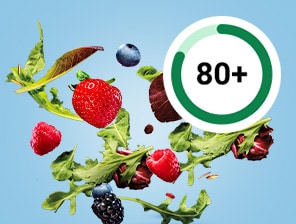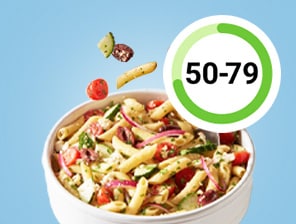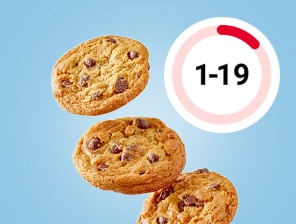OptUP®
Eating well, simplified.

Your OptUP® score shows how nutritious your household purchases are – no logging or tracking, just shop with your Card.

Items scored 80-100.

Items scored 80-100.

Items scored 50-79.

Items scored 50-79.

Items scored 20-49.

Items scored 20-49.

Items scored 1-19.

Items scored 1-19.
We’ve teamed up with the FoodHealth Company to bring you their FoodHealth Score—a simple way to understand how nutritious your food is. The FoodHealth Score rates foods from 1 to 100, so you can easily see the nutrition quality of what you're buying. The higher the score, the better the choice! To check nutrition ratings as you shop, look for the nutrition information on each product page.
The FoodHealth Score is based on two main factors:
What Boosts the Score?
Foods get a higher score when they have high ingredient quality and high nutrient density.
Foods with High Ingredient Quality
Foods with High Nutrient Density
What Lowers the Score?
Foods get a lower score when they have low ingredient quality and low nutrient density.
Foods with Low Ingredient Quality
Foods with Low Nutrient Density
Why It Matters:
Choosing foods with a higher FoodHealth Score can help you make smarter choices. Look for the score on your favorite items to start eating better today!
The FoodHealth Score can help you identify nutritious options within food and beverage categories, such as comparing cereals or frozen entrees. In addition to being scored, products are color-coded into green, light green, yellow, and red groups to identify healthier food faster.
Dark Green (80 and above): These foods tend to be higher in protein, fiber, healthy fats, and may include fruits, vegetables, nuts, or whole grains. Our dietitians recommend filling your cart with dark green foods and eating them at every meal.
Light Green (50–79): These foods offer a balance of nutrients like fiber, protein, and whole grains while being moderate in saturated fat, sodium, and sugar. A significant portion of your cart should be light green foods and we recommend you eat these foods daily.
Yellow (20–49): These foods have less nutritional value compared to higher-rated options. Aim to include a moderate amount of yellow foods in your cart and strive to enjoy these foods a few times per week.
Red (19 and below): These foods tend to have the lowest nutritional value and may have more saturated fat, sodium, and added sugar. Add these foods to your cart for special occasions and enjoy them in moderation, as all foods can fit into a balanced diet.
The FoodHealth Scores from your recent purchases are used to calculate your OptUP® Score. The higher the score, the more nutritious your purchases. By monitoring your score over time, you can better understand the nutritional value of your purchases. Our goal is to make it simple and sustainable for you to shop and eat well. Unlike other tools that help you reflect on the health and nutrition of your food, there is no tedious manual logging of food or meals required. Simply use your Shopper’s Card when buying groceries at one of the Kroger Family of Companies and then visit Nutrition Insights to analyze your purchases.
Our team of expert Registered Dietitians recommend aiming for an OptUP® Score above 600. To achieve a score above 600, most of the food you purchase will need to have OptUP® nutrition ratings above 60. This can help you eat the nutrients you need while still enjoying all your favorite foods. To reach this goal, our Registered Dietitians recommend adding more dark and light green items to your cart. Add yellow items to enjoy a few times per week and limit red items for special occasions.
Opting for healthier choices has never been easier. Look for the “OptUP® to Better For You” carousel on each product page to find similar but higher scoring options for your favorite products. Additionally, explore your My Nutrition Insights (link) to understand the FoodHealth Scores of products from previous purchases. Add more of your highest-rated items to your cart for a boost in OptUP® score.
Looking for an easy way to increase your score? Add more fruits, vegetables, whole grains or lean proteins to your basket.
Already above the target range? Ask yourself if your goal should be to increase it further or look to maintain the current OptUP® Score month over month.
Better for You options are similar but healthier and higher-rated versions of the foods and beverages you’re already shopping for. We include recommendations for similar products that make it easy for you to swap. Better for You options have higher FoodHealth Scores than the original item you were viewing. These suggestions have a healthier balance between more positive attributes, such as whole grains or fiber, and attributes that should be consumed mindfully, like added sugar or sodium.
Pharmacy, Clinic, and Nutrition services are available in select areas. Access our pharmacy locator to find a pharmacy near you. The Little Clinic practices in the following states only: AZ, KY, OH, TN, CO, IN, GA, KS, VA. Access our clinic locator to find a clinic near you. Walk-ins welcome as time allows. Nutrition services are not available in AK, MT, NH, NJ, PA, RI, NY, SC, WY, or where otherwise prohibited by applicable law.